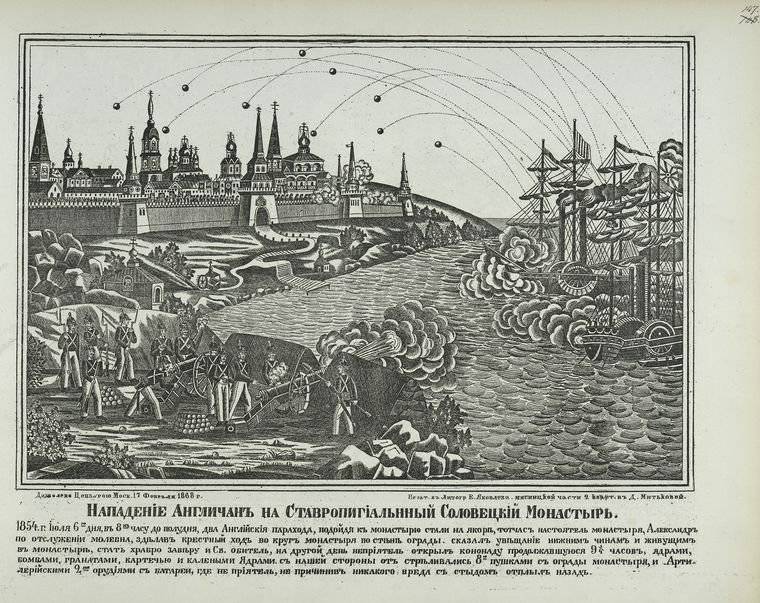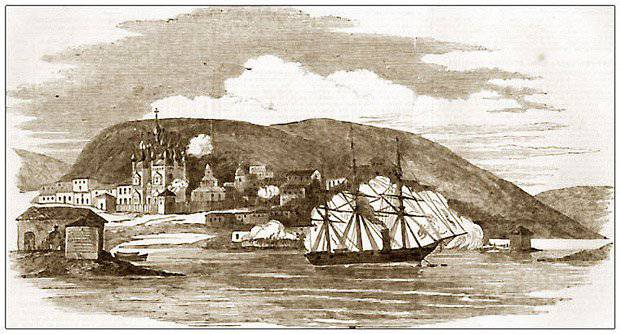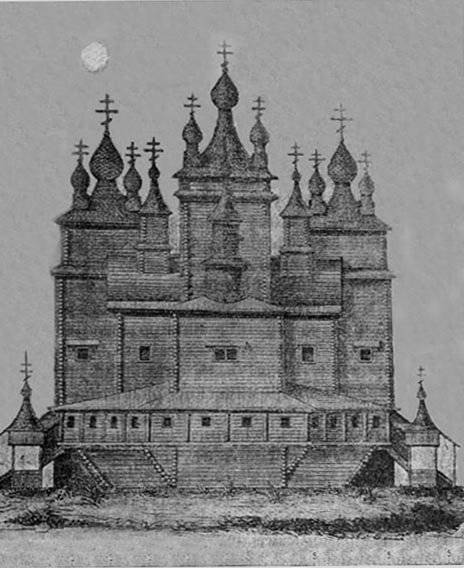The barbaric attack of the British on the Solovki monastery and the burning of Coke
The British launched an expedition to the White Sea. Already in May, the British sent three steamboats to blockade the White Sea. Then a few more English and French ships were sent there. The squadron commanded the English captain Oman. 5 (17) June an enemy squadron appeared at the entrance to the White Sea. The original actions of the British were limited to the seizure of small merchant ships loaded with bread and fish. 22 June (4 July) the English reached the Mudyug Island, which was located in the Dvina Bay of the White Sea, near the mouth of the Northern Dvina, and sent several boats to measure the depths. However, they were driven away by the fire of two cannons of Ensign Baldin and rifle shooting from the boats of Lieutenant Tveritinov.
Defense of the Solovetsky Monastery
On July 6 (18), two steamships Miranda and Brisk (Agile) attacked the Solovetsky Monastery. The steamboat frigate Miranda had 15 cannons, and the Agile one had 14. The British considered the monastery a strong fortress, but nevertheless decided to try to take it, as they hoped to capture the treasures that, according to rumors, were rich in Russian churches. On Solovki took into account the possibility of the appearance of an enemy fleet, therefore, all monastic values were already exported to Arkhangelsk. According to the Ministry of War, the monastery had “20 pounds of gunpowder, spears and many reeds and axes from the time of Fyodor Ivanovich from defense means”. A battery with two three-pound guns was built on the shore, and another 8 small guns were placed on the walls and towers. The monastery was defended by a detachment of an invalid team.
Reference. Starting from the time of Peter I, soldiers in the Russian Empire were named as soldiers who received diseases, injuries or mutilations who were not able to perform military military service, and they were assigned to serve in civilian institutions, train new recruits or to perform guard duty. During the reign of Peter I, maimed, wounded, decrepit officers, constables, dragoons, privates were sent to monasteries. They were kept at the expense of the monasteries.
Anchored, the British ships immediately, without entering into negotiations, opened fire. They destroyed the monastery gates and bombarded the monastic buildings. Fireworks Drushlevsky responded shots from the coastal battery and was able to damage the "Miranda". After that, the British moved away.
7 (19) in July, the British captain Omani sent a truce and announced that since “the Solovetsky monastery assumed the character of a fortress and fired at the English flag”, it requires an unconditional surrender of the garrison with all the guns, weapons, flags and military supplies for 6 hours. Otherwise, he threatened the bombardment of the fortress. Archimandrite Alexander replied with a refutation of lies concerning guilt in the shooting of the British flag, as the Russians began to answer only after the third core, fired into the monastery. They refused to surrender.
Then began the bombing, which lasted more than nine hours. For our part, the disabled and hunters (volunteers) responded with fire from 10 guns. British bombs and cores caused some damage, but less than expected. The bombardment, for all its considerable intensity and duration, did not destroy the entire Solovetsky monastery, although the roof was pierced by the cores and the walls were damaged. There were no human victims. The strength of the English artillery was weakened by the fact that the enemy ships tried to keep a distance so as not to come under fire. The defenders believed that the British would land. Initially, apparently, they had this idea, but the British did not do it and 8 (20) July retreated.
Archimandrite Alexander and the entire population of the island showed real heroism, refusing to capitulate to the superior forces of the enemy. Russian people preferred to fall in an unequal battle, not having modern weapons, than voluntarily admit the enemy to the Russian land. Sovereign Nicholas ordered to award the Rector of the Solovetsky Monastery, Archimandrite Alexander, with a pectoral diamond cross on the Ribbon of St. George, and the monks Matthew, Barnabas and Nikolai for their excellent performance of their duties during the English attack, were marked with gold pectoral crosses on the St. George ribbon.
From the Solovki monastery, the British went to the deserted Hare Island, where they ruined and plundered the wooden church. Then in the Onega Bay robbed the village Lyamitskaya. 9 (21) July, the English appeared at Ky Island, in 15 versts from the town of Onega, where they burned down customs and other state-owned buildings. On the same island robbed the Monastery of the Cross. 10 (22) July, the British landed a team on the eastern shore of the Gulf of Onega, near the village of Pushlakhty. There were no Russian troops here, but the peasants (23 man), under the command of the two lower ranks and the assistant of the Kholmogory district head of the Ministry of State Property Volkov, resisted. They killed 5 people, wounded several, and retreated without loss. The British, in revenge, plundered and burned the village.
Later, Tsar Nicholas rewarded courageous people. Volkov was granted the Order of St. Anna 3 degree, non-officer Basov insignia of the Military Order and 25 rubles, and the usual Ievlev 15 rubles. All peasants received 5 rubles, the most honorable were given the insignia of the Military Order.

Cola Destruction
It should be noted that the danger of the situation of the Cola was noticed in March 1854. 2 March 1854, the Kola mayor Shishelov sent a report to Arkhangelsk military governor Boyle. In it, he said that if England wished to send part of its fleet to the northern shores of the Russian state, "in this case, the city of Cola can also not escape from his attention by the ease of capture ..." In the city there was no garrison, except for a few dozen ordinary disabled teams that were armed with only about 40 suitable guns, with a minimum amount of ammunition, no artillery weapons. Military Governor Boyle, for his part, wrote in March 1854 of the year to the Kola mayor that “the inhabitants of Cola are brave and intelligent people, and therefore I hope that they will not allow the enemy into their city, but will destroy it with shots from steep banks and because of bushes” . And to guide the residents sent Captain Pushkarev with 100 rifles and ammunition. Pushkarev was instructed to use a terrain character convenient for defense. The attack on the settlement could only be carried out on rowing ships and it was necessary to land on the steep shore.
However, Pushkarev stayed in the city for long. He was injured by some intruder and departed. The captain was able to track down two guns, one 2-pound and another 6-pound, but one of them turned out to be faulty, and the other during the battle could only make one shot. In addition, the parapet was built to shelter the soldiers. The military governor Boyle identified Lieutenant Brunner, who arrived in the city in August, as successors to Pushkarev.
The 9 (21) of August, the Miranda steamer-frigate appeared in Coke's mind. English boats began to carry out the measurement of the depths. 10 August, the British continued to measure, put the buoys. The Russians did not open fire from the existing gun, because of the considerable range they were afraid to spend the shots for nothing. At 8 one o'clock in the evening of the same day, the British ship raised a white flag and approached the coast. From the steamer “Miranda” a boat was sent to the shore. The British demanded an unconditional surrender of the city, fortifications and the garrison, threatening to destroy Coke otherwise. Although there was no modern fortification in Kohl (the fortification of the prison was outdated long ago, and there was virtually no artillery armament), and the entire garrison was made up of an 50 wheelchair person, the adjutant of the Arkhangelsk military governor, fleet lieutenant Andrei Martynovich Brunner answered with a strong refusal. He assembled a disabled team and several hunters (volunteers) from local residents and prepared for defense. All residents of the town expressed their willingness to sacrifice themselves and their property to repel the enemy.
Brunner, waiting for the immediate commencement of the bombing of the city, withdrew his small forces from the coastal strip under the cover of the steep banks of the Cola and Tuloma rivers. And at dusk, the lieutenant called the hunters (volunteers) to remove the buoys set by the British and take the fishing vessel they had seized to a new place. The volunteers volunteered the petty bourgeois Grigory Nemchinov and the exiles Andrei Mishurov and Vasily Vasilyev. They successfully completed their mission, removing ten buoys.

The steamer frigate "Miranda" destroys the city of Cola
On the morning of August 11 (23), British ships began shelling the city. The bombing continued until late in the evening. In addition, the enemy tried several times to make a landing with troops, sending boats with armed men to the shore, but each time a small detachment of disabled people and hunters under the command of Lieutenant Brunner stopped these actions. The lower part of the town, consisting of wooden structures, was completely destroyed. About 100 houses burned down, an old fortress with 4 towers in the corners, 2 churches, several shops. The upper part of the city survived. There were no people killed, several people received light wounds and contusions.
During the bombardment, the masterpiece of Russian wooden architecture burned down. The Resurrection Cathedral, built under the tsars John and Peter Alekseevich in 1684. The cathedral along with the Transfiguration Cathedral in Kizhi was one of the largest many-headed temples of the Russian North. The cathedral had 19 chapters (according to other sources, the chapters were 18, one was removed during the 1834 repair of the year) and, having stood for 170 for years, surprised everyone with its beauty and durability.
12 (24) of August, from early in the morning, the bombing of Cola was resumed again and continued until 7 in the morning. The British tried to set fire to the upper part of the Coke, but they could not do it. After that, the British retreated, without waiting for the surrender of Coke and not deciding on the landing.
Russian Emperor Nikolai, having received a report on the defense of Kola, Lieutenant Brunner noted the Order of St.. Vladimir 4 degree with a bow, captain of the 1 th Archangelgorodsk garrison battalion of Pushkarev - Order of St. Anna 3 degree with a bow, non-commissioned officer Fedotov - a badge of the Military Order. The exiled Mishurov and Vasilyev were transferred to Arkhangelsk for temporary residence.
In late August, the British appeared at the town of Onega. On the first alarm, the military team joined the 250 townspeople, armed with guns, lances and pikes, ready to defend their city. However, the enemy did not dare to attack and retreated. At the fighting in the North stopped.

Resurrection Cathedral (Cola)
Information